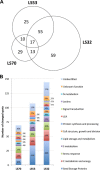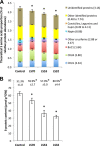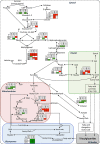Evidence for proteomic and metabolic adaptations associated with alterations of seed yield and quality in sulfur-limited Brassica napus L
- PMID: 24554741
- PMCID: PMC4014277
- DOI: 10.1074/mcp.M113.034215
Evidence for proteomic and metabolic adaptations associated with alterations of seed yield and quality in sulfur-limited Brassica napus L
Abstract
In Brassica napus, seed yield and quality are related to sulfate availability, but the seed metabolic changes in response to sulfate limitation remain largely unknown. To address this question, proteomics and biochemical studies were carried out on mature seeds obtained from plants grown under low sulfate applied at the bolting (LS32), early flowering (LS53), or start of pod filling (LS70) stage. The protein quality of all low-sulfate seeds was reduced and associated with a reduction of S-rich seed storage protein accumulation (as Cruciferin Cru4) and an increase of S-poor seed storage protein (as Cruciferin BnC1). This compensation allowed the protein content to be maintained in LS70 and LS53 seeds but was not sufficient to maintain the protein content in LS32 seeds. The lipid content and quality of LS53 and LS32 seeds were also affected, and these effects were primarily associated with a reduction of C18-derivative accumulation. Proteomics changes related to lipid storage, carbohydrate metabolism, and energy (reduction of caleosins, phosphoglycerate kinase, malate synthase, ATP-synthase β-subunit, and thiazole biosynthetic enzyme THI1 and accumulation of β-glucosidase and citrate synthase) provide insights into processes that may contribute to decreased oil content and altered lipid composition (in favor of long-chain fatty acids in LS53 and LS32 seeds). These data indicate that metabolic changes associated with S limitation responses affect seed storage protein composition and lipid quality. Proteins involved in plant stress response, such as dehydroascorbate reductase and Cu/Zn-superoxide dismutase, were also accumulated in LS53 and LS32 seeds, and this might be a consequence of reduced glutathione content under low S availability. LS32 treatment also resulted in (i) reduced germination vigor, as evidenced by lower germination indexes, (ii) reduced seed germination capacity, related to a lower seed viability, and (iii) a strong decrease of glyoxysomal malate synthase, which is essential for the use of fatty acids during seedling establishment.
Figures







Similar articles
-
Improving seed germination and oil contents by regulating the GDSL transcriptional level in Brassica napus.Plant Cell Rep. 2019 Feb;38(2):243-253. doi: 10.1007/s00299-018-2365-7. Epub 2018 Dec 10. Plant Cell Rep. 2019. PMID: 30535511
-
Integration of proteomic and genomic approaches to dissect seed germination vigor in Brassica napus seeds differing in oil content.BMC Plant Biol. 2019 Jan 11;19(1):21. doi: 10.1186/s12870-018-1624-7. BMC Plant Biol. 2019. PMID: 30634904 Free PMC article.
-
Tuning of sulfur flow and sulfur seed metabolism in oilseed rape under sulfate-limited conditions.J Exp Bot. 2025 May 27;76(8):2278-2296. doi: 10.1093/jxb/eraf028. J Exp Bot. 2025. PMID: 39869110
-
Integration of omics approaches to understand oil/protein content during seed development in oilseed crops.Plant Cell Rep. 2017 May;36(5):637-652. doi: 10.1007/s00299-016-2064-1. Epub 2016 Oct 27. Plant Cell Rep. 2017. PMID: 27796489 Review.
-
Seed proteomics.J Proteomics. 2011 Apr 1;74(4):389-400. doi: 10.1016/j.jprot.2010.12.004. Epub 2010 Dec 21. J Proteomics. 2011. PMID: 21172463 Review.
Cited by
-
Seed Yield Components and Seed Quality of Oilseed Rape Are Impacted by Sulfur Fertilization and Its Interactions With Nitrogen Fertilization.Front Plant Sci. 2019 Apr 16;10:458. doi: 10.3389/fpls.2019.00458. eCollection 2019. Front Plant Sci. 2019. PMID: 31057573 Free PMC article.
-
Sulfur in Seeds: An Overview.Plants (Basel). 2022 Feb 6;11(3):450. doi: 10.3390/plants11030450. Plants (Basel). 2022. PMID: 35161431 Free PMC article. Review.
-
Is there an oilseed rape ideotype that can efficiently withstand sulfur deficiency?J Exp Bot. 2025 May 27;76(8):2039-2042. doi: 10.1093/jxb/eraf133. J Exp Bot. 2025. PMID: 40425528 Free PMC article.
-
SuMoToRI, an Ecophysiological Model to Predict Growth and Sulfur Allocation and Partitioning in Oilseed Rape (Brassica napus L.) Until the Onset of Pod Formation.Front Plant Sci. 2015 Nov 17;6:993. doi: 10.3389/fpls.2015.00993. eCollection 2015. Front Plant Sci. 2015. PMID: 26635825 Free PMC article.
-
Assessment of Sulfur Deficiency under Field Conditions by Single Measurements of Sulfur, Chloride and Phosphorus in Mature Leaves.Plants (Basel). 2018 Apr 28;7(2):37. doi: 10.3390/plants7020037. Plants (Basel). 2018. PMID: 29710786 Free PMC article.
References
-
- McGrath S. P., Zhao F.-J. (1996) Sulphur uptake, yield responses and the interactions between nitrogen and sulphur in winter oilseed rape (Brassica napus). J. Agr. Sci. 126, 53–62
-
- Zhao F.-J., Bilsborrow P. E., Evans E. J., McGrath S. P. (1997) Nitrogen to sulphur ratio in rapeseed and in rapeseed protein and its use in diagnosing sulphur deficiency. J. Plant Nutr. 20, 549–558
-
- Scherer H. W. (2001) Sulphur in crop production—invited paper. Eur. J. Agron. 14, 81–111
Publication types
MeSH terms
Substances
LinkOut - more resources
Full Text Sources
Other Literature Sources

